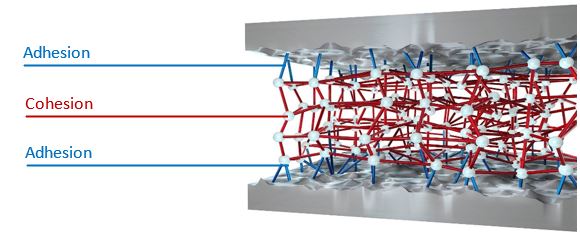
Understanding the fundamentals of adhesives is essential in choosing the appropriate adhesive, for a specific need and for the desired results. Here, ARaymond looks at how engineers can choose the appropriate adhesives.
Industrial adhesives are made from polymers that join materials by two phenomena - adhesion of the adhesive on both substrates and cohesion of the adhesive with its internal strength.

The combination of adhesion and cohesion determines bonding effectiveness. Both must be considered when choosing the right adhesives and surface treatments.
Adhesion
Adhesion can be defined as the adhering of similar or different types of materials to each other. It depends on:
There are three types of bond between the adhesive and the substrate – mechanical, physical and chemical. Mechanical adhesives fill the pores of the surface roughness, resulting in mechanical anchoring between the two surfaces. For a physical bond, two materials are held together by Van der Waals forces or hydrogen bonds: the attraction between positively and negatively charged molecules.
Lastly, a chemical bond is a chemical reaction between the molecules of the adhesive and the molecules of the substrate surface forms a covalent bond (the strongest bond).

Adhesion is improved by working on wettability, but also on substrate roughness (mechanical), on polarity (physical), or by possible activation of the surface to form covalent bonds (chemical). When adhesion is not sufficient, if a stress is applied on the bond, it will lead to an ‘adhesive failure’ of the assembly - it means that the failure will occur between the substrate and the adhesive joint.
Adhesive failure is easy to identify as there is almost no adhesive residue on the substrate:

Adhesive failure must be avoided as it is non-repeatable and unpredictive. Various possibilities exist to improve and control adhesion. Among them: surface cleaning, mechanical preparation or chemical activations. In addition, some adhesive technologies are more suitable for some surface materials than others.
Cohesion
Cohesion refers to the inner strength of the adhesive. The cohesion depends on:
Cohesive failure occurs when the bond between molecules within the adhesive is forced to failure because the external force exceeds the cohesive bond. It means that the external force is stronger than the covalent forces.
Cohesive failure is easy to identify as the adhesive joint is split. Both bonded surfaces still have adhesive residue on them:

As seen, bonding involves adhesion and cohesion phenomena that will influence the performance of the assembly. The objective is to understand and control these phenomena to obtain reliable bonds over time. For good bonding assembly, the best adhesive will never reach expected performances if it is not suitable for the materials to bond and if it is not properly implemented.

Having spent a decade in the fastener industry experiencing every facet – from steel mills, fastener manufacturers, wholesalers, distributors, as well as machinery builders and plating + coating companies, Claire has developed an in-depth knowledge of all things fasteners.
Alongside visiting numerous companies, exhibitions and conferences around the world, Claire has also interviewed high profile figures – focusing on key topics impacting the sector and making sure readers stay up to date with the latest developments within the industry.
Don't have an account? Sign Up
Signing up to FastFixTechnology.com enables you to manage your account details.